

Senior project student, Olivia Vasseur introducing her series, The Search for Belonging, during the opening of Senior Projects, Fall 2024. Photo courtesy of Caitlin Rosolen.
Senior Projects - Fall 2025
Location: Wasmer Art Gallery
Dates: December 5 - December 12, 2025
Opening Reception and Artists’ Presentation: Thursday, December 4, 5-7pm
At the end of their studies, art majors are required to develop and present a coherent body of self-generated work. This exhibition combines their knowledge of techniques and concepts while drawing on research of historical and contemporary artists. Each senior art major in the exhibition designs and creates a unique installation that combines their technical skills and conceptual vision.
Sponsored by the Layden Family Foundation, the Smith Family Foundation of Estero, and WGCU Public Media.
-
Paige Caldwell TIME TO DANCE
Toggle More Info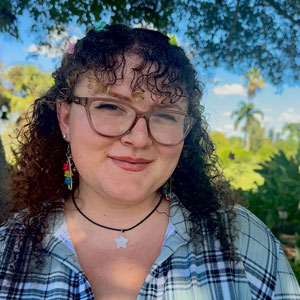
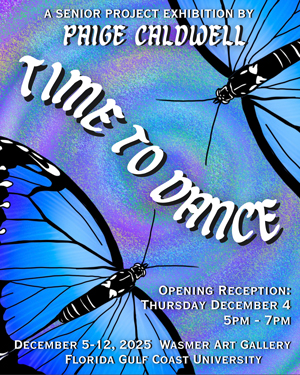
Butterflies are like dancers - their movements appear fleeting, but each gesture carries meaning. Colors and patterns are central to how they survive, reproduce, and navigate their environment. When they display their brightly colored wings, it serves as a form of communication, signaling their species and gender to attract a mate, or acting as a distraction to evade predators. When multiple butterflies join in flight as part of a mating ritual, individuals circle one another in a graceful motion. Groups of butterflies flying together may also indicate rivalry, as one attempts to chase another away from a prospective mate. Capturing and showcasing these movements requires a collaborative effort that blends artistic expression with science, technology, engineering, and mathematics (STEM).
To launch this project, I went to visit Butterfly World in Coconut Creek, Florida, with the intention of appreciating the beauty of butterflies. I became captivated not just by their form and color, but by the way they move, the delicate flutter of their wings, their playful flights together, and the way they circle and dance down the pathways. Observing this natural choreography inspired me to translate their kinetic energy into art. Each piece in my series explores a different aspect of butterfly motion. Lonely Dance captures the solitary elegance of a single Glasswing butterfly. Duet depicts two Common Morpho butterflies in a perpetual courting dance. The Chase brings to life a playful pursuit of Gray Glassy Tiger butterflies, and Time to Dance transforms actual butterfly flight paths into a visual representation. This project combines my passions for art and STEM, challenging me to merge creativity and technical precision as I explore how to share the dance of butterflies with a gallery audience.
Bringing this vision to life required a combination of digital fabrication, mechanical systems, and installation design. I created templates for three butterfly species (Glasswing, Common Morpho, and Gray Glassy Tiger) in the Procreate software. Matthew Losey, a staff member from the FGCU Library Maker Space, was able to translate these drawings into the 3D models using Bambu Studio. The butterfly frames were 3D printed, filled with reflective materials, and fused together with a soldering tool before being suspended to create the illusion of flight. Motors were added to Lonely Dance and Duet to generate movement, while Time to Dance visually recreates butterfly flight paths recorded from videos I captured at Butterfly World. Origami butterflies trace these paths, incorporating paper gifted to me by my late grandfather who introduced me to the practice of origami. Through collaboration, iteration, and experimentation with STEM, the project merges observation and invention, creating a kinetic scene that is the intersection of art, science and technology.
-
McKenzie Donahue ADAGIO
Toggle More Info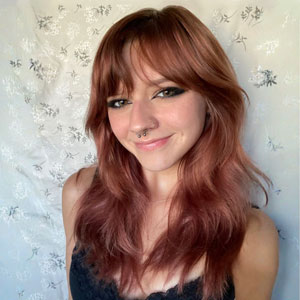
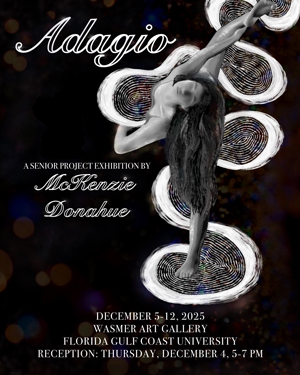
“Dance training is life training... I don’t know how to do anything else. I don’t care how to do anything else, without the music and joy of movement.” - Joe Tremaine
Like movement, art exists in a constant state of evolution. Organic shapes and recurring patterns mirror the rhythms we find in nature; the flow of our bodies in motion, the quiet pauses in between, and the invisible threads that connect us to one another. These forms personify balance and exchange, echoing patterns found in the tides, the repetition of breath, music’s lively pulse, and the visual harmonies that shape the natural and creative world. In their fluidity they suggest communication without words. Motion extends beyond form and medium revealing how pattern, whether choreographed or drawn, becomes a bridge between body and art.
My artistic practice is rooted in the language of movement. For eighteen years, dance has continued to be my most natural form of communication where emotion, intuition, and physical awareness converge. That form of thinking and sensing never left my body, it simply shifted mediums. When drawing, I enter the same meditative headspace I cultivated in the dance studio. I rely on breath, music, and physical grounding to quiet my mind and align my body, just as I would before stepping into choreography. Once this flow state is created the work begins to unfold intuitively. Lines stretch, arc, and weave across the page with the same sustained intention as an adagio ballet sequence. In this rhythm, my patterns feel less constructed and more organically generated. The visual arts are my personal extension of physical expression where pattern becomes movement and movement becomes meaning. The most valuable work emerges directly from this meditative state.
This embodied approach translates directly into my materials and methods as well. I work on mixed-media paper using alcohol-based Sharpie inks, pulling pigment slowly across the surface to embrace the improvisation of line. The tactile drag of the marker guides my pacing and pressure, determining when a line should glide freely or pause momentarily. My Polymorph and Clove patterns are formed by responding to these lines, growing structure in real time. I find the colors of Sharpie ink extremely eye-catching and easy to blend, allowing me to experiment with selective color in my patterns and build upon balance and interaction. Space has also become an active collaborator in my pieces, both within and beyond the page. I stretch patterns to the edges of the page, cluster them tightly, or leave voids to cultivate tension and mirror body language. The square and rectangle dimensions of my paper contain and expand space around my patterns, organizing variety for the viewer to embrace. Each choice I make on the page forms a visual choreography like dancers on a stage, shaped by intuition, repetition, and the physical sensations and joy of expression.
-
Makeila Gonzalez MIRAME CUANDO ME RECUERDES
Toggle More Info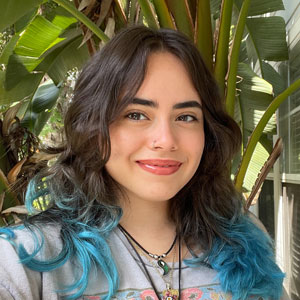
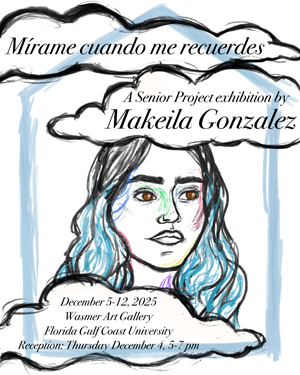
Does home reside in the physical spaces we inhabit, or does it reside in our memories? Ancient Greek philosophers believed there was a technique used for memory recollection called Ars Memoria which proposes that the mind is space, and memories are placed among the rooms of that space. Our minds are often referred to as something we live in, much like a home. These airy rooms of recollection house smells, objects, people, and images that can bring us back to scenes of love, comfort, and belonging. Yet memory is fleeting, and as our physical homes evolve and fade with time, the memories that shape this sense of home do as well.
As a queer second generation Hispanic American, my sense of belonging has constantly shifted. Oftentimes, I find home in one culture or community over the others, or in none. Due to the transient nature of where I have found shelter, I hold onto the images and memories of those times with great devotion, and also with great fear. As I grow older, I fear loss more; as the people I love move and pass away and I leave the places I call home, the more it becomes clear to me that a lot of what’s left over are my memories. Painting them is how I honor the precious moments in my life and the elusive nature of memory. For this project I chose to depict the five different spheres of what home is to me. Home is my father, my mother, my sister, and my friends, and the home I build within myself.
To portray my devotion, I created collaged studies with pictures of my loved ones and personal symbols that trigger my memories. After collaging these images into a respective space, I began to paint those scenes onto shaped wood panels to solidify them. The shape of each panel is inspired by cloud formations and the different areas of the brain. Every panel is a room that represents a person or community that has shaped my sense of home. I chose painting with acrylic as my primary medium because the physicality and flow of moving the paintbrush gives me the space to reconnect with my memories in a tangible and intentional manner.
¿El hogar reside en los espacios fiscos que habitamos, o reside en nuestros recuerdos? Los filósofos griegos antiguos creían que existía una técnica para la recuperación de la memoria llamada Ars Memoria, que propone que la mente es un espacio y que los recuerdos se ubican en las zonas de ese espacio. Frecuentemente se hace referencia a nuestra mente como algo en lo que vivimos, de forma muy parecida a un hogar. Estas luminosas habitaciones de la memoria albergan olores, objetos, personas e imágenes que pueden transportarnos a escenas de amor, consuelo y pertenecía. Sin embargo, la memoria es fugaz, y como nuestros hogares fiscos evolucionan y se desvanecen con el tiempo, también lo hacen los recuerdos que dan forma a este sentimiento de hogar.
Como miembro de la comunidad LGTB, Hispana y estadounidense de segunda generación, mi sentido de pertenecía ha estado en constante cambio. A veces me siento como en casa en una cultura o comunidad más que en otras, o en ninguna. Debido a la naturaleza transitoria de los lugares donde he encontrado refugio, me aferro a las imágenes y recuerdos de aquellos tiempos con gran devoción y también con gran temor. A medida que envejezco, temo más la perdida: a medida que las personas que amo se mudan y fallecen, y yo dejo los lugares que llamo hogar, me queda cada vez más claro que gran parte de lo que queda son mis recuerdos. Pintarlas es mi forma de honrar los momentos preciosos de mi vida y la naturaleza esquiva de la memoria. Para este proyecto elegí representar las cinco esferas de lo que significa el hogar para mí: mi papa, mi mama, mi hermana y mis amigos, y el hogar que construyo dentro de mí.
Para demostrar mi devoción, cree collages con fotografías de mis seres queridos y símbolos personales que evocan recuerdos. Tras reunir estas imagines en un espacio determinado, comencé a pintar esas escenas sobre paneles de madera con formas para darles solidez. La forma de cada panel está inspirada en las formaciones de nubes y las diferentes áreas del cerebro. Cada panel es una habitación que representa a una persona o comunidad que ha influido mi concepto de hogar. Elegí la pintura acrílica como mi medio principal porque la fiscalidad y el flujo del movimiento del pincel me brindan el espacio para reconectarme con mis recuerdos de una manera tangible y intencional.
-
Destiny Harvin BECOMING
Toggle More Info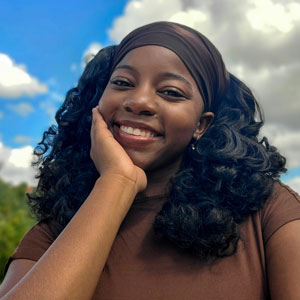

My work is rooted in the emotions of release, of letting go of the fear, grief, and pain that has shaped so much of my journey. This project focus on the transition from holding onto weight that no longer serves me to finally experiencing the lightness of freedom and relief. The concept came from personal moments where I realized that healing is not about erasing what hurt us but about learning to breathe again without it pressing on our chest. My art captures that tension between heaviness and release, transforming it into imagery that reflects both struggle and liberation.
Through this senior project I translate my internal experience into a visible form. My work becomes a visual language for emotions often left unspoken the weight of pain, the endurance required to carry it, and the quiet shift that occurs when we choose to put it down. These sculptures are grounded in my own lived experiences and can speak to anyone who has ever felt the heaviness of holding on and the courage it takes to let go. I used my own body as a point of scale to center the figures in believable human proportion. The figures, titled Catch, Fear, and Release, stand in to represent stages of holding and then letting go, the stages of becoming. Catch reflects the moment we look for someone else to rescue us from the confusion of our own emotions. Fear embodies the pressure and paralysis that follow. Lastly, Release captures the loosening of that weight and the beginning of becoming something new.
For this body of work, I used life-size foam figures to turn emotional and psychological states into a physical presence. Using my own body for measurement, I carved each form from one-and-a-half-inch insulation foam. To make the figures more three-dimensional, I doubled the foam panels and bonded them with spray foam. Once everything dried, I shaped the muscles with drywall sanding paper and used both heavy and light spackle to fill cracks and create a smooth, plaster-like surface. I coated the finished forms with gesso so the paint would hold. In the backgrounds, I created flowers from thin foam sheets and used heat to bend and curl them into soft, organic shapes. I painted the figures and flowers with acrylics, using darker tones to express fear and grief and lighter tones to show release and clarity. The whole process became its own form of becoming, shaping the work and shaping me at the same time.
-
Maya Miller EYE CONTACT
Toggle More Info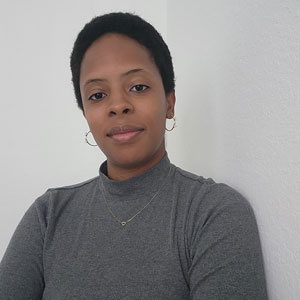
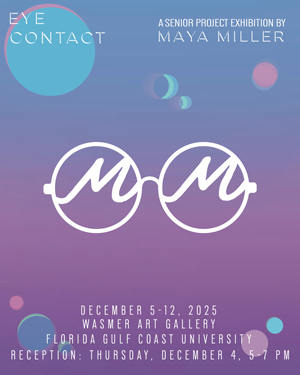
From the reflection in a mirror to the glow of our smart digital screens, the self-portrait has served humanity one purpose: defining self. Each piece is inspired by self-portrait artists such as Jan van Eyck and Cindy Sherman, who are known for studying the individual. Their series of portraits focused on engaging with the viewer. Sherman, for instance, experimented with different characters in wardrobe and makeup to engage her audience. Participating in this vulnerable act of self-study, the viewer is asked to recognize the shared human effort to find oneself within the daily performance of life.
Challenging myself to make unwavering eye contact with the viewer, I confronted my own timid nature and the struggle I have with daily interpersonal engagement. For as long as I have been drawing portraits, my focus has been external subjects with unique features and desired traits. Drawing portraits of others was often an act of projection or reimagining myself as them. The decision to draw a series of portraits of myself should not be mistaken for self-admiration, but as a mandated self-study. The canvas in question is now a mirror where I approach my own image with the same critical eye used for drawing others. The core intention of this work is to use the artistic process itself as a tool to research, document, and ultimately confront the vulnerabilities I attempt to conceal in my daily life. My Senior Project ultimately tested my abilities as both an artist and an individual, since the journey has encouraged me to be more confident in everything I encounter. These self-portraits now invite the viewer to contact my eyes in a moment of shared, vulnerable confrontation.
For the development of these digital artworks, I used Procreate, Adobe Illustrator, and Photoshop to address the minutiae in my pieces. For a more personalized approach, I enhanced the individuality of each image by creating or editing brushes for refinement. Specific brushes had similar properties as oil paint, spray paint, and ink, which can be found within the more vibrant compositions. A series of self-portrait photos were taken in various poses and lighting, and they were applied to the canvas as a ground layer for development. While isolating each layer was a challenge, I was able to rely on my photographic references to stay organized.
-
Ke’Siah Parsons THE HAIRSTORY
Toggle More Info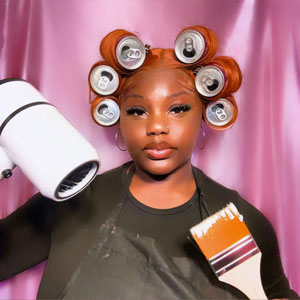
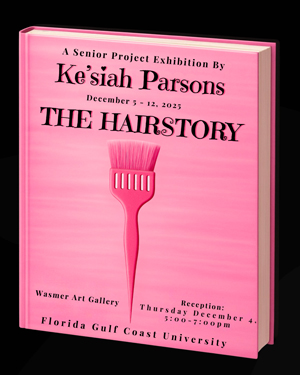
“From childhood forward, our hair is one of the most critical, defining aspects of our embodied selves as black women: how we get it done … how we have to focus on it … the questions we have to answer about it.” ~ Melissa Harris-Perry.
In Black culture hair has always been more than just looks. It tells a story about our origins, who we are, and what we carry with us. For many generations hair has served to communicate; braids that show age or family connections, styles that represent freedom or protection, and texture that stands for pride, judgment, or resistance. Even today, our hair is filled with memories – the scent of grease on wash day, the sound of beads clacking on swings at the playground, and the connections made through hands, scalp, and stories. Black hair embodies history, identity, creativity, and survival all at once, linking this project not only to me but also to the communities that recognize the importance of every parting line, every hot comb, every curl pattern, every big chop, and every new beginning.
My personal journey with hair is both artistic and meaningful. I enjoy changing my own hairstyle because every change allows me to reinvent myself and express where I am in life at that moment. As a hairstylist, every head I work on becomes a canvas, giving me the opportunity to restore confidence and help someone feel complete again. This idea is central to my paintings. The first piece in my series, Nostalgia, evokes memories of childhood braids, beads, and barrettes, the early styles that helped shape who I am. The second painting represents The Big Chop, a journey to embrace my natural hair and a time of growth, vulnerability, and self-acceptance. The self-titled SIAH delves into identity through wigs, and the ability to switch things up, play around, hide, reveal, or transform into someone new for a day. The small companion paintings document the hair tools and products used for each of the transformations depicted in the larger works. Creating these pieces brings me joy because it allows me to celebrate the beauty and complexity of Black hair while honoring the different versions of myself that I have experienced.
My artwork starts with carefully layered acrylic backgrounds that are filled with floral designs and rhythmic lines. Each brushstroke is placed with intention to create a sense of movement, depth, and an atmosphere that feels both homey and dreamlike. On top of this artistic foundation, I add 3D elements like synthetic hair, beads, combs, and textured materials. I shape and manipulate these elements just like I would style real hair—by parting, twisting, layering, and adding volume. This mix of detailed painting techniques and sculptural hair-based materials allows the artwork to extend beyond the flat canvas, turning each piece into a lively representation of identity, memory, and the beauty and intricacy of Black hair. The materials do more than just decorate the paintings—they complete them, connecting the tangible reality of hair with the expressive nature of paint.
-
Katie Ann Shashaty SONGBIRD
Toggle More Info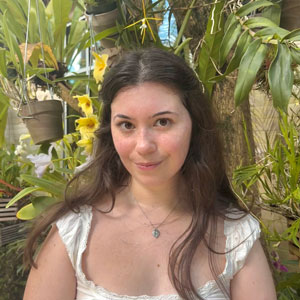

Across culture and time, art has served as a vessel for memory, grief, and the preservation of personal histories. Objects and imagery take on symbolic weight when words fall short, especially in the wake of loss. The natural world, and birds in particular, are recurring motifs in memorial art representing transcendence, freedom, or the continued presence of the departed. Through my research, I discovered many artists of Lebanese decent, like my grandmother and me, who also associate birds with the symbol of freedom. This greatly influenced me to reunite with heritage as a way of connecting more with my grandmother throughout the process of senior project. By using domestic and natural imagery like nests and birdhouses, this project explores how care, memory, and safety can be physically shaped and held, even after those we associate with them are gone.
Songbird is a personal tribute to Anna Shashaty, my grandmother, who was a gentle and loving and protective presence during my childhood. Her warmth and kindness were foundational to my sense of safety and identity. She loved birds, and since her passing, as well as the passing of both my parents, songbirds have come to symbolize their spirits and the emotional lineage they left behind. This work honors her tenderness and the refuge she provided me, while also navigating the quiet ache of grief and the enduring comfort of memory. The installation consists of clay birdhouses and nests, formed to evoke a sense of both fragility and permanence. Embedded or placed within these structures are personal objects and materials that specifically evoke the memory of my grandmother, such as seashells or knitting yarn. Surrounding and connecting these sculptures are delicate drawings of songbirds, strung gently throughout the space to create a sense of movement and presence. The accordion style illustration book is a series of pages that reflect written words and imagery relating my grandmother. The combination of tactile ceramics and ephemeral drawings invites viewers to move between the physical and emotional layers of remembrance.
Each of my ink and watercolor bird paintings reflects the songbirds I regularly meet in my time spent outdoors. They are displayed on a garland banner that I crocheted using acrylic yarn. The accordion book I created features colored pencil and ink illustrations that correspond to the writing on the adjacent pages, which contain cherished memories and keepsakes from my grandmother. The birdhouses are crafted from porcelain, chosen for its symbolic association with preciousness and purity, while the bird nests are made from porcelain paper clay. Finally, the two still life drawings portray authentic objects I inherited from my grandmother.
